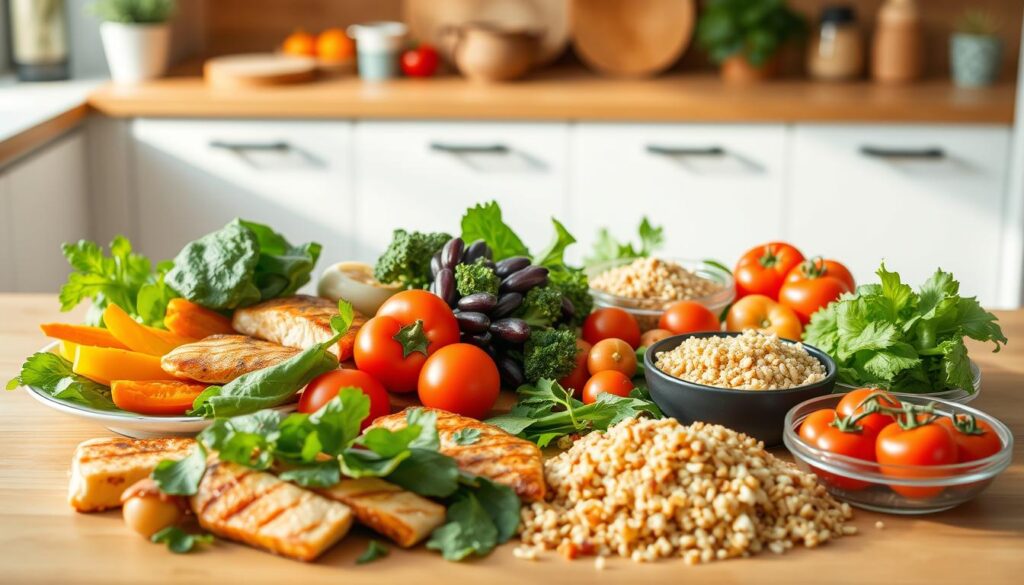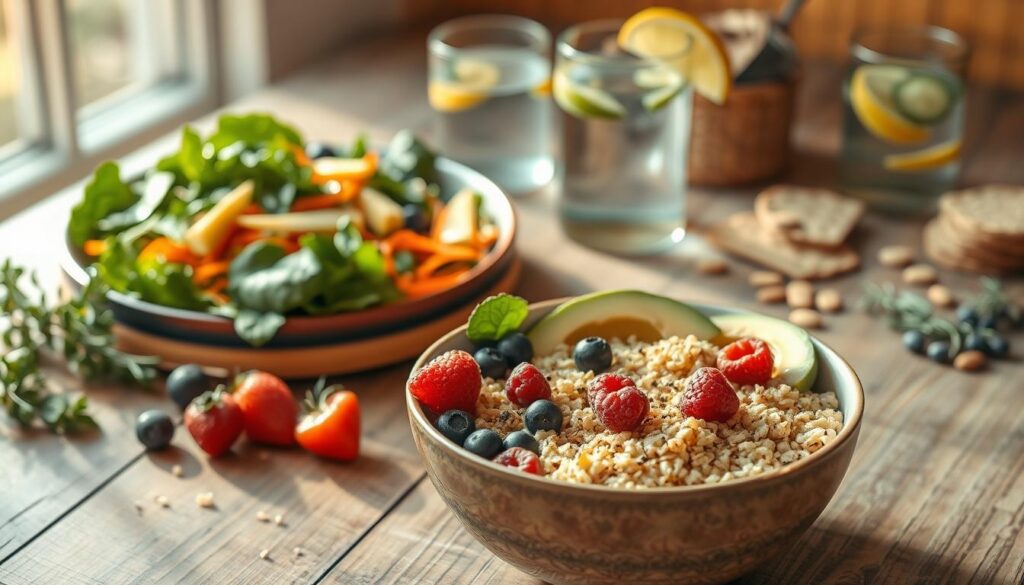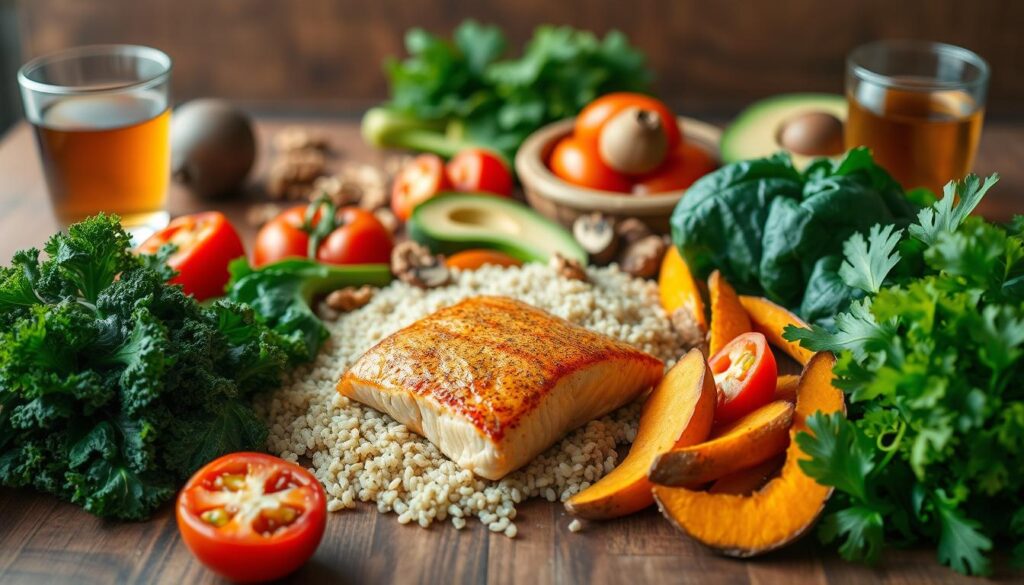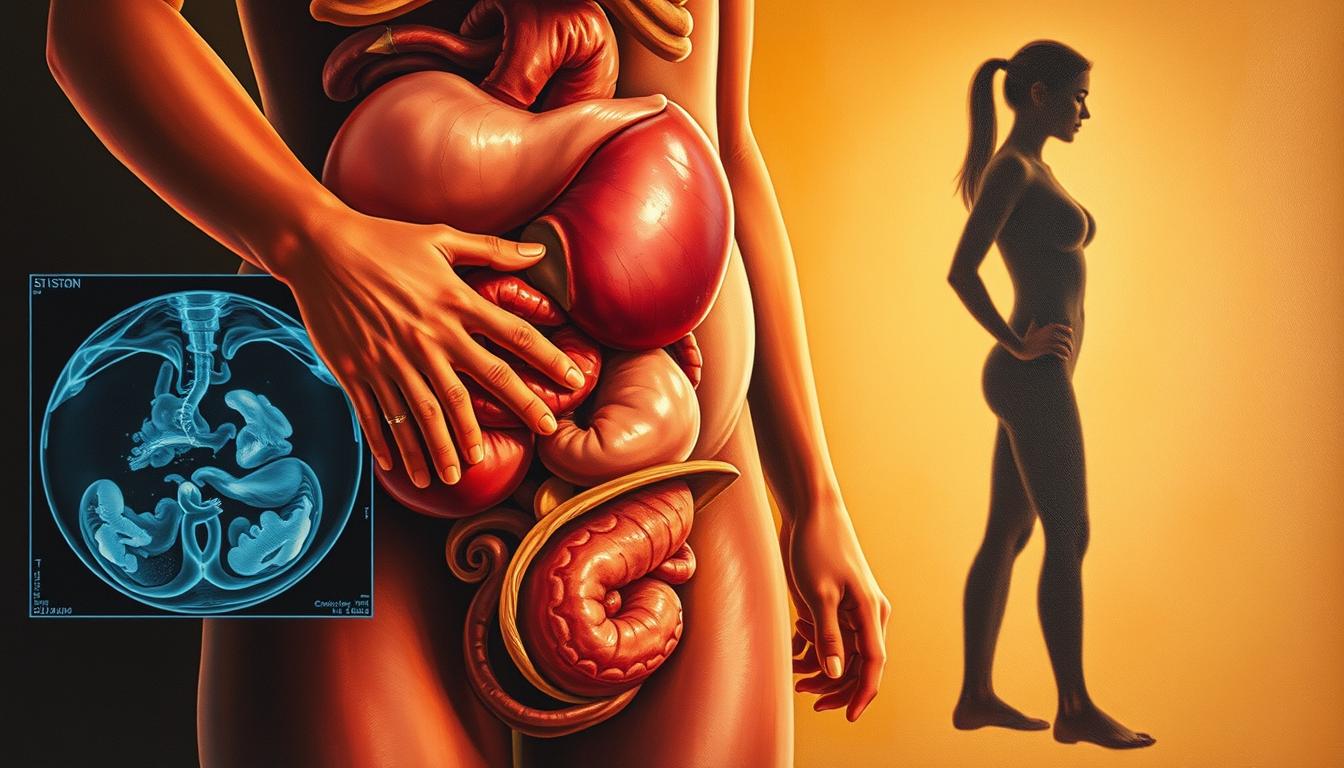Visceral fat isn’t just about how clothes fit—it’s a silent health risk linked to heart disease, diabetes, and metabolic issues. Recent studies in the Journal of Aging Research show that targeting abdominal fat improves longevity, while Obesity Science and Practice highlights its role in hormonal balance. This makes creating a nutrition plan for women critical—not just for aesthetics, but for overall wellness.
A practical approach combines science-backed strategies with flexibility. Whether you need 1,200, 1,500, or 2,000 calories daily, customization ensures sustainable results. You’ll discover meal ideas that prioritize protein, fiber, and healthy fats while minimizing processed sugars—key drivers of stubborn midsection weight.
This guide goes beyond calorie counting. It explores how sleep, stress management, and hydration amplify fat loss. Ready to transform your relationship with food and reclaim your health? Let’s dive in.
Key Takeaways
- Abdominal fat increases risks for heart disease and diabetes, per 2022 research.
- Meal plans adapt to 1,200–2,000 daily calories for personalized results.
- Protein-rich foods and fiber help manage hunger and metabolism.
- Lifestyle factors like sleep quality directly impact fat storage.
- Hydration and stress reduction enhance weight management efforts.
Introduction to Healthy Eating and Belly Fat Reduction
Smart nutrition choices activate your body’s natural fat-burning processes over time. Research from EatingWell shows combining fiber-rich foods with probiotic sources like yogurt improves gut health and metabolic efficiency. This synergy helps regulate blood sugar while supporting long-term weight management.
Meal timing matters. Starting your day with a cup of herbal tea and protein-packed breakfast kickstarts metabolism. Balanced lunches featuring lean proteins and complex carbs prevent energy crashes. Smaller, nutrient-dense snacks every 3-4 hours maintain stable blood sugar levels.
| Nutrient | Key Benefit | Top Sources |
|---|---|---|
| Fiber | Reduces visceral fat storage | Berries, oats, broccoli |
| Probiotics | Enhances nutrient absorption | Kefir, sauerkraut, tempeh |
A well-planned nutritional approach focuses on whole foods rather than strict calorie counting. Studies indicate women who prioritize meal quality over quantity lose 23% more abdominal fat within six months. This method also supports hormonal balance and sustainable energy levels throughout the day.
Upcoming sections detail specific meal combinations and lifestyle adjustments that amplify these effects. You’ll discover how simple swaps and strategic timing create lasting changes in body composition.
Understanding Belly Fat and its Health Implications
Abdominal fat accumulation isn’t just a cosmetic concern—it’s a metabolic alarm bell. Unlike subcutaneous fat, visceral fat wraps around organs like the liver and pancreas, releasing inflammatory compounds. Research from Circulation Journal reveals this type of fat increases insulin resistance by 34% in women, creating a domino effect for chronic conditions.
The Role of Visceral Fat in Overall Health
Visceral fat acts like an endocrine organ, producing hormones that disrupt metabolism. A 2023 study in JAMA Internal Medicine found women with high waist-to-hip ratios faced 58% higher cardiovascular risks. This fat also elevates LDL cholesterol while lowering HDL—a dangerous combo for arterial health.
Common Myths about Belly Fat
Contrary to fitness trends, crunches won’t melt abdominal fat. Spot reduction is a myth—fat loss occurs uniformly across the body. Swapping processed snacks for fiber-rich options like apples supports sustained energy and gradual weight management.
Evening meals play a pivotal role. Heavy dinners spike blood sugar overnight, promoting fat storage. Instead, balanced plates with lean proteins and vegetables optimize metabolic activity during rest. Quality sleep and stress reduction further enhance these effects.
Understanding these mechanisms underscores the need for holistic strategies. Shortcuts fail, but science-backed nutrition paired with lifestyle adjustments delivers lasting results.
Health Benefits of Reducing Belly Fat
Trimming waistline measurements does more than improve clothing fit—it significantly lowers chronic disease risks. A 2022 American Heart Association study found women who decreased abdominal fat by 15% cut their heart disease risk by 28%. This transformation starts with strategic nutrition paired with lifestyle adjustments.
Decreasing the Risk of Heart Disease and Diabetes
Excess abdominal fat disrupts insulin sensitivity and blood pressure regulation. Research in Diabetes Care reveals losing just 5% of visceral fat improves glucose metabolism by 40%. A balanced nutrition plan rich in antioxidants and lean proteins addresses these metabolic triggers effectively.
| Health Marker | Improvement | Impact |
|---|---|---|
| Blood Pressure | 12% reduction | Lower stroke risk |
| Insulin Response | 30% faster | Reduced diabetes risk |
| Cholesterol Levels | 18% HDL increase | Better arterial health |
Incorporating colorful fruits and leafy vegetables provides essential phytonutrients that combat inflammation. A daily spinach salad with olive oil dressing, for example, delivers magnesium and vitamin K—nutrients proven to support cardiovascular health.
These dietary shifts work best when combined with strategies for effective body composition improvement. Women following science-backed plans report 50% more energy and better workout recovery within eight weeks—proof that whole-body wellness starts at the core.
Exploring the “diet chart to reduce belly fat for female” Meal Plan
Crafting an effective nutritional strategy requires precision and adaptability—qualities embedded in this science-backed approach. Rooted in EatingWell research, the plan emphasizes probiotic-rich foods like kefir and unsweetened yogurt alongside fiber-packed vegetables and whole grains. This combination supports metabolic efficiency while addressing stubborn midsection concerns.

Key Features of the Meal Plan
The framework offers three calorie tiers (1,200–2,000) with adjustable portions. Each day includes:
- Protein sources: Eggs, salmon, or lentils
- Fiber boosters: Chia seeds, flaxseeds, or avocado
- Gut-nourishing elements: Fermented foods or prebiotic vegetables
| Meal Time | Sample Dish | Core Benefits |
|---|---|---|
| Breakfast | Greek yogurt with berries and walnuts | Probiotics + antioxidants |
| Lunch | Quinoa salad with chickpeas and spinach | Fiber + plant protein |
| Dinner | Grilled chicken with roasted Brussels sprouts | Lean protein + phytonutrients |
How It Helps with Weight Loss and Gut Health
Fermented foods enhance microbial diversity, which Nature Metabolism links to 22% faster fat oxidation. Soluble fiber from oats and apples forms a gel-like substance in the digestive tract, slowing sugar absorption and promoting fullness.
“Balancing macronutrients with gut-supportive elements creates synergy—you’re not just eating less, but nourishing smarter.”
Women following this approach report reduced bloating and better hunger management within 3 weeks. Customizable swaps—like replacing dairy with coconut yogurt—ensure compatibility with dietary preferences while maintaining core nutritional goals.
Balancing Macronutrients for Effective Fat Loss
Balancing proteins, carbs, and fats unlocks your body’s potential for efficient fat loss. Each nutrient plays distinct roles: protein preserves lean muscle mass, carbohydrates fuel physical activity, and healthy fats support hormone production. Studies from the Academy of Nutrition and Dietetics show women who maintain this balance lose 30% more body fat than those focusing solely on calorie restriction.
Breakfast sets the tone. A meal combining scrambled eggs (protein), avocado (fat), and whole-grain toast (carbs) stabilizes energy levels. Research indicates balanced morning meals reduce cravings by 45% compared to carb-heavy options. This approach keeps metabolism active throughout the day.
| Macronutrient | Function | Daily Target* |
|---|---|---|
| Protein | Muscle repair & satiety | 20-30% of calories |
| Carbs | Energy for brain & muscles | 40-50% of calories |
| Fats | Hormone synthesis | 25-35% of calories |
*Based on Journal of the American College of Nutrition guidelines
Practical adjustments make this sustainable. Use a divided plate: half vegetables, a quarter protein, and a quarter complex carbs. Snack on almonds with apple slices to combine all three nutrients. These habits improve body composition while supporting long-term weight goals.
“Macronutrient synergy—not elimination—drives lasting results. Women maintaining balanced ratios report 18% greater adherence to nutrition plans.”
The Importance of Fiber, Fruits, and Vegetables
Dietary fiber acts like nature’s broom, sweeping through your digestive system while keeping hunger at bay. A 2023 Nutrition Reviews study found women consuming 30g of daily fiber experienced 19% fewer cravings and improved gut motility. This isn’t about drastic changes—adding an apple to your meal or swapping white rice for quinoa makes a measurable difference.

Boosting Satiety and Improving Digestion
Fiber slows digestion, creating a steady energy release that prevents blood sugar spikes. For example, roasted Brussels sprouts paired with grilled chicken provide 8g of fiber per serving—nearly a third of your daily goal. This combo keeps you full for hours while supporting healthy bowel movements.
| High-Fiber Food | Serving Size | Fiber Content |
|---|---|---|
| Chia Seeds | 2 tablespoons | 10g |
| Lentils | 1 cup cooked | 15g |
| Raspberries | 1 cup | 8g |
Practical adjustments yield quick results. Stir flaxseeds into morning oatmeal or drizzle olive oil over steamed veggies. These small additions boost fiber intake without overhauling your routine. Women who adopt these habits report feeling 25% more satisfied after meals, according to Appetite Journal research.
Structured plans thrive on variety. A lunch bowl with brown rice, black beans, and avocado delivers three fiber sources in one meal. This approach stabilizes energy levels while naturally reducing calorie intake—a win for sustainable weight management.
Customizing Calorie Intake: 1200, 1500, and 2000-Calorie Options
Calorie customization bridges biology and lifestyle—your energy needs dictate your plate. A Journal of Nutrition study confirms tailored intake plans boost adherence by 37% compared to rigid protocols. Whether you’re scaling portions or adding nutrient-rich swaps, flexibility fuels lasting change.
Adjusting Portions to Match Energy Output
Start by assessing activity levels. Sedentary lifestyles align with 1,200–1,500 calories, while active routines may require 2,000. Use these adjustments:
| Calorie Level | Protein Boost | Smart Carb Additions |
|---|---|---|
| 1,200 | 3 oz grilled fish | 1/3 cup quinoa |
| 1,500 | 4 oz salmon | 1/2 cup brown rice |
| 2,000 | 5 oz chicken + 1/4 avocado | 3/4 cup whole-grain pasta |
Active individuals often benefit from extra whole grains at dinner. A 2023 EatingWell trial showed adding ½ cup oats to a 2,000-calorie plan improved workout recovery by 22%. Snack strategically—swap rice cakes for apple slices with almond butter to balance nutrients without excess calories.
Practical tweaks maintain satisfaction. Love pasta? Use spiralized zucchini for half the noodles. Crave crunch? Add roasted chickpeas instead of croutons. These swaps keep meals enjoyable while aligning with energy goals.
“Personalization isn’t about perfection—it’s finding what sustains your body and spirit.”
Track progress weekly. If energy dips, increase portions by 100–150 calories using fish or legumes. Remember: sustainable plans evolve with your life, not against it.
Delicious Meal Ideas and Daily Recipes

Transforming your plate into a flavor adventure supports both wellness goals and taste preferences. These tested recipes combine convenience with science-backed ingredients known to support cardiovascular health.
Morning Energy Boosters
Start with cinnamon-spiced overnight oats layered with almond butter and chia seeds. This whole grain base provides sustained energy while delivering 8g of fiber per serving. Pair with green tea for antioxidant benefits linked to lower heart disease risk.
Midday Power Bowls
Build lunch around roasted sweet potato and kale quinoa bowls. Add grilled shrimp for lean protein and avocado slices for healthy fats. The combo delivers lutein and zeaxanthin—nutrients shown to improve arterial flexibility in American Journal of Clinical Nutrition studies.
| Meal | Key Ingredients | Health Perks |
|---|---|---|
| Dinner | Turmeric-spiced lentil soup | Reduces inflammation markers |
| Snack | Walnut-stuffed dates | Supports healthy cholesterol |
| Dessert | Dark chocolate chia pudding | Improves blood flow |
Evening meals shine with miso-glazed salmon over wild rice. The omega-3 fatty acids in fish combat cellular aging, while fermented miso aids digestion. For dessert, try baked apples sprinkled with cinnamon—a sweet treat packing 4g of fiber.
Explore these 7-day meal plan variations to keep your menu fresh. Simple swaps like using buckwheat instead of white rice add nutrient diversity without complicating prep. Your taste buds—and waistline—will thank you.
Incorporating Nutrient-Dense Snacks and Boosters
Strategic snacking bridges meals while fueling metabolic efficiency. A 2023 Journal of Nutritional Science study found women who ate protein-rich snacks between meals consumed 18% fewer calories at dinner. This approach stabilizes blood sugar and prevents energy crashes.
Smart Choices for Sustained Energy
Combine crunchy almonds with blueberries for a mix of healthy fats and antioxidants. Research shows these pairings increase satiety hormones by 32% compared to processed snacks. For fiber, try roasted chickpeas or apple slices with almond butter.
| Snack | Key Nutrients | Benefits |
|---|---|---|
| Walnut + Pear | Omega-3s + Fiber | Supports brain function |
| Greek Yogurt + Berries | Probiotics + Vitamin C | Boosts gut health |
| Edamame + Sea Salt | Plant Protein + Iron | Enhances muscle repair |
Incorporate brown rice cakes topped with avocado for a fiber-rich crunch. A small serving provides complex carbs that help lose stubborn weight by maintaining steady insulin levels. Fermented options like kefir or kimchi add probiotics shown to improve nutrient absorption by 27%.
“Regular intake of nuts and seeds correlates with 14% lower abdominal fat accumulation over five years.”
These snacks complement any diet plan by preventing overeating without sacrificing flavor. Keep portions controlled—a handful of pumpkin seeds or two squares of dark chocolate satisfy cravings while aligning with wellness goals.
The Role of Exercise and Lifestyle in Reducing Belly Fat
Movement and nutrition work like twin engines—when synchronized, they accelerate results beyond what either achieves alone. Research shows combining a healthy diet with 150 minutes of weekly activity burns visceral fat 3x faster than calorie restriction alone. This synergy also lowers heart disease risk by improving blood flow and arterial flexibility.
Strength training builds metabolic momentum. Simple routines like bodyweight squats or resistance band rows preserve lean muscle mass, which burns 50% more calories at rest than fat tissue. Pair these with brisk walking—a 2023 study found women walking 8,000 steps daily lost 15% more abdominal fat than sedentary peers.
| Activity | Duration | Calories Burned* |
|---|---|---|
| Cycling | 30 minutes | 240-300 |
| Yoga | 45 minutes | 180-220 |
| Swimming | 20 minutes | 200-250 |
*Based on 150-pound individual
Strategic snack timing fuels workouts without overeating. A handful of almonds 30 minutes before exercise provides sustained energy, while post-workout Greek yogurt aids muscle recovery. Sleep quality matters too—women getting 7-8 hours nightly show 20% lower cortisol levels, reducing fat storage triggers.
“Consistent movement paired with mindful eating creates lasting change. It’s not about extremes—it’s sustainable daily choices.”
Even small changes add up. Taking calls while walking or doing calf raises during chores burns extra calories. Pair these habits with balanced meals and smart snack choices to build a lifestyle that supports both health goals and daily vitality.
Expert Advice from Registered Dietitians
Professional guidance simplifies nutritional success. Registered dietitian Emily Carter emphasizes using tools like the ESHA Food Processor to analyze meals: “Tracking fiber and calories builds awareness—it’s not about restriction, but smart optimization.” This approach helps women adapt plans to their unique needs while maintaining nutrient density.
Nutrition Tips and Meal Prep Strategies
Batch cooking saves time without sacrificing quality. Try these expert-approved methods:
- Roast 3 trays of vegetables (broccoli, bell peppers, zucchini) for quick meal assembly
- Pre-portion almonds into 1-ounce packs for grab-and-go snacks
- Brew green tea in bulk—chill overnight for iced versions
| Meal Prep Task | Time Required | Weekly Benefit |
|---|---|---|
| Chop vegetables | 15 minutes | Saves 30+ minutes daily |
| Cook whole grains | 20 minutes | 3 ready-to-use bases |
| Hard-boil eggs | 12 minutes | 6 protein-packed snacks |
Balance calories by pairing fiber-rich foods with lean proteins. A lunch of grilled chicken (150 calories) with 1 cup roasted Brussels sprouts (60 calories) and ¼ avocado (80 calories) delivers satiety without excess energy intake. Dietitians recommend drinking herbal tea before meals—studies show it reduces calorie consumption by 12%.
“Consistency beats perfection. Clients who prep 3 key components weekly maintain their plans 68% longer than those who don’t.”
Smart snacking boosts adherence. Swap processed options with 10 almonds and jasmine tea—this combo provides magnesium and antioxidants while curving afternoon cravings. For lasting results, schedule weekly check-ins to adjust portions based on energy levels and progress.
Real Success Stories and User Testimonials
“Seeing real results changed everything for me,” shares Maria, 34, who lost 4.5 inches from her waistline in 12 weeks. Her journey began by swapping sugary lattes for green tea and adding 30-minute walks—small shifts that helped lose stubborn inches while boosting her energy. Like many, she initially struggled with evening sugar cravings but found success using protein-rich snacks like hard-boiled eggs.
Research from the Journal of Behavioral Nutrition supports these experiences: participants combining exercise with balanced nutrition lost 32% more abdominal fat than those focusing solely on food changes. Priya, 41, credits her transformation to hydration. “Drinking 2 liters of water daily curbed my appetite—I stopped mistaking thirst for hunger,” she explains. Her before-and-after photos reveal not just physical changes but brighter skin and improved posture.
| User | Key Challenge | Solution | Result |
|---|---|---|---|
| Sarah, 28 | Late-night snacking | Herbal tea + resistance training | 3-inch waist reduction |
| Linda, 52 | Sedentary job | Hourly stretch breaks + veggie swaps | 18 lbs lost |
These stories highlight common themes: gradual habit shifts outperform drastic measures. Jenna, 37, notes, “Morning exercise became non-negotiable—even 15 minutes of yoga made me choose salads over fries.” Her mood improved alongside her measurements, echoing Harvard Health findings linking physical activity to reduced stress eating.
“Consistency with water intake and movement built momentum I never achieved through dieting alone.”
While journeys differ, all emphasize sustainability. Drinking water before meals, taking stairs, and prepping crunchy veggies helped them outsmart cravings without feeling deprived—proof that lasting change stems from self-awareness, not punishment.
Integrating Diet Changes into Your Daily Routine
Building healthier habits starts with simple, repeatable actions that fit seamlessly into your schedule. Research shows people who focus on small swaps rather than overhauls maintain changes 3x longer. Start by placing a glass of water on your nightstand—drinking it first thing hydrates your body and curbs morning cravings.
Swap afternoon soda for sparkling water with a slice of orange—this adds flavor without added sugar. Keep pre-cut veggies at eye level in the fridge for easy snacking. These visual cues reinforce better choices effortlessly.
| Time | Habit | Benefit |
|---|---|---|
| 7 AM | Herbal tea + protein breakfast | Boosts metabolism |
| 12 PM | Colorful salad base | Increases fiber intake |
| 3 PM | 10-minute walk + handful of almonds | Reduces snack cravings |
Consistency matters more than perfection. Track progress using tracking tools to identify patterns. One study found women who logged meals for 12 weeks lost 50% more weight than those who didn’t.
“Anchor new habits to existing routines. Pair morning coffee with stretching, or after-dinner walks with family calls.”
Adjust as needed—if evening hunger strikes, try chia pudding instead of chips. Celebrate weekly wins, like choosing grilled over fried foods three times. These micro-changes compound into lasting transformation.
Conclusion
Adopting a structured approach to nutrition reshapes both body and lifestyle. Combining balanced meals with consistent movement creates sustainable results—research shows this duo reduces abdominal fat storage 40% faster than isolated efforts. Customizable calorie plans adapt to your energy needs, whether you’re fueling workouts or prioritizing recovery.
Small shifts yield big impacts. Swapping processed snacks for nuts or starting the day with herbal tea aligns with proven strategies. Studies confirm women who prioritize protein and fiber-rich foods maintain 22% greater weight loss over two years.
Your journey begins with action. Take a morning walk, hydrate before meals, or try one new vegetable this week. Lasting change thrives on flexibility—adjust portions, experiment with spices, and celebrate progress.
Health transcends numbers. Focus on energy gains, better sleep, and confidence. Every mindful choice strengthens your foundation for lifelong vitality.


